NGC 2261
| ||
 Zmienna Mgławica Hubble’a (HST) | ||
| Odkrywca | William Herschel | |
| Data odkrycia | 26 grudnia 1783 | |
| Dane obserwacyjne (J2000) | ||
| Gwiazdozbiór | Jednorożec | |
| Typ | mgławica refleksyjna | |
| Rektascensja | 06h 39m 09,5s | |
| Deklinacja | +08° 44′ 40″ | |
| Odległość | 2500 ly (766 pc) | |
| Jasność pozorna mgławicy | 9,0m | |
| Rozmiary kątowe | 3′ × 1'[1] | |
| Charakterystyka fizyczna | ||
| Wymiary | ~ 1 ly | |
| Alternatywne oznaczenia | ||
| Zmienna Mgławica Hubble’a, LBN 920, C46, H IV-2, h 399, GC 1437, CED 83, HH 39, PP 64 | ||
NGC 2261 (również Zmienna Mgławica Hubble’a) – mgławica refleksyjna znajdująca się w konstelacji Jednorożca. Została odkryta 26 grudnia 1783 roku przez Williama Herschela[1]. Mgławica ta znajduje się w odległości około 2500 lat świetlnych.
NGC 2261 jest powiązana z młodą gwiazdą R Monocerotis. Układ ten należy do najdokładniej badanych układów gwiazda-mgławica w ciągu ostatnich 100 lat. Mgławica ta kształtem przypominająca stożek jest pusta w środku. Źródłem mgławicy jest znana od 150 lat gwiazda zmienna, która od jej odkrycia ulegała wahaniom o cztery wielkości gwiazdowe. Zmienna Mgławica Hubble’a zawdzięcza swą nazwę badaniom Edwina Hubble’a, który w 1916 roku odkrył, że mgławica ta może ewoluować w skali miesięcy. Gwałtowne zmiany jasności NGC 2261 są spowodowane przez cień pyłu krążącego wokół gwiazdy R Monocerotis.
Przypisy
Bibliografia
- Robert Gendler: Niebo. Warszawa: Carta Blanca, 2007, s. 89. ISBN 978-83-60887-00-4.
- NGC 2261 w serwisie APOD: Astronomiczne zdjęcie dnia
Linki zewnętrzne
Media użyte na tej stronie
Autor: Judy Schmidt from Fresh Meadows, NY, USA, Licencja: CC BY 2.0
This is a reprocessing of one of the older Hubble Heritage releases. I believe that when it was originally processed that the individuals responsible did the best they could with the tools they had. Better software and faster computing allow me to improve significantly upon the original, which was created in 1999.
This object lies along the Milky Way's dusty plane in the constellation Monoceros. One of my favorite things about this kind of nebula is that it reminds us that there can be a lot unseen in space. An optical illusion is produced by human intuition: it may look to you as though this is a bright cloud against a dark surface. In reality, this is a small hole in a largely unseen cloud which allows for light from a newly forming star to shine through.
The variation in the nebula is most likely caused by shadows being cast by blobs of dust accreting near the young star. Note that the accretion process and the star itself are impossible to see in this image, and they occur at a scale too small and too distant for Hubble to see in any detail. The presence of the dusty knots and their close proximity to the star can be inferred by the shadows they cast and how fast they move across the nebula. Because the nebula is around a light year in size, the shadows appear to flow outward, which demonstrates to us the speed of light (or the speed of darkness?) in a way that I find profoundly beautiful. Wouldn't it be wonderful if the telescope could observe this object many more times so we could watch the light flow lazily through the Universe?
I found a ground-based animation of the nebula's variation here: www.umanitoba.ca/faculties/science/astronomy/cbrown/imagi...
Some more information and the original news release is here: hubblesite.org/image/904/news_release/1999-35
An APOD is here: apod.nasa.gov/apod/ap991020.html
Data collected for Proposal 5574 made this image possible. WF/PC2 Cycle 4: Polarization Proposal
Red: F814W;POLQ Green: F675W;POLQ Blue: F555W;POLQ
North is 120° clockwise from up.